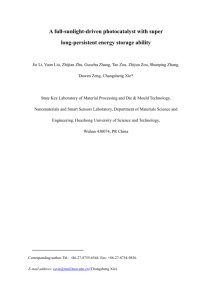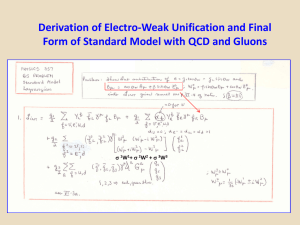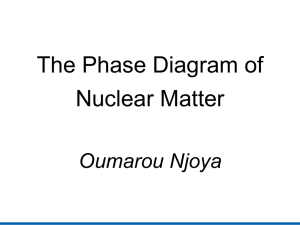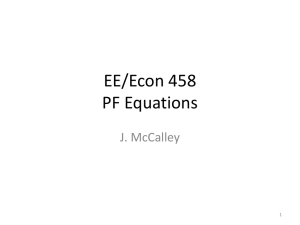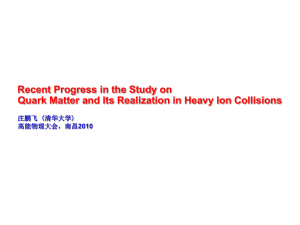Document
advertisement
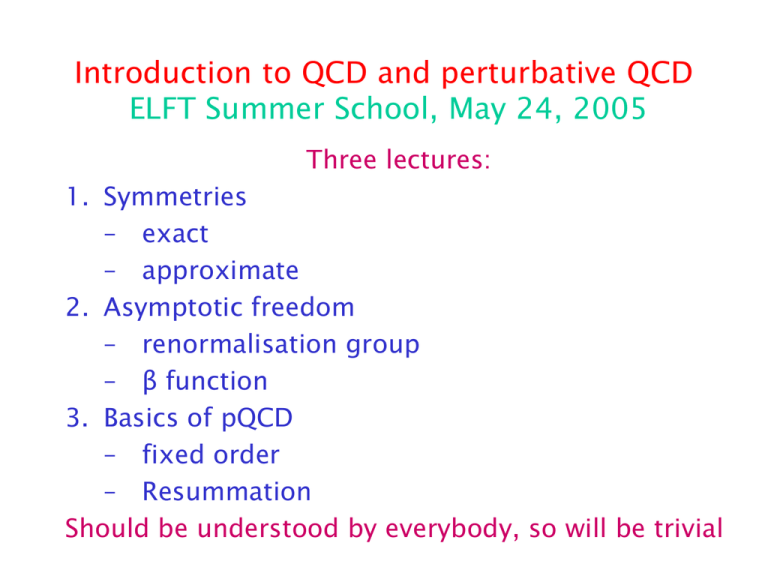
Introduction to QCD and perturbative QCD ELFT Summer School, May 24, 2005 Three lectures: 1. Symmetries – exact – approximate 2. Asymptotic freedom – renormalisation group – β function 3. Basics of pQCD – fixed order – Resummation Should be understood by everybody, so will be trivial When you measure what you are speaking about and express it in numbers, you know something about it, but when you cannot express it in numbers your knowledge about is of a meagre and unsatisfactory kind. Lord Kelvin Field content • Quark fields: qf f=1,…,6 B=1/3 f 1 2 3 4 5 6 qf u d s c b t mf ~5MeV ~7MeV ~100MeV 1.2GeV 4.2GeV 174GeV mf running masses (see later) at =2GeV, approximate values; Nf is the number of light quarks (e.g. 3) •Gluon fields: Aɑ ɑ=1,…,8 The QCD Lagrangian • QCD is a QFT, part of the SM • The SM is a gauge theory with underlying SUc(3) SUL(2) UY(1) LQCD L 0 QCD 0 QCD L L sources QCD LC LGF LGhost The Classical Lagrangian Nf 6 1 a a LC F F q f i D q f q f i D m f q f 4 f 1 f N f 1 , 0 , 2g 5 D igs Aa T a are the SU(Nc) generators with algebra: Ta T ,T if a b abc T c TR 1 / 2 T r T a T b TR ab fundamental representation: adjoint representation: 1 a T ta 2 T a bc iabc Fbca a The Classical Lagrangian Colour factors (like eigenvalues of J2): •in the fundamental representation: t t a a bc CF bc N c2 1 CF TR Nc •in the adjoint representation: F F a a bc CAbc CA 2TR Nc Fa Aa Aa igs Fbca Ab Ac source of non-Abelian nature: gluon self coupling Note: in lattice QCD gs A A a a F a 1 a F gs Exact symmetries of the classical Lagrangian • Quantum effects may violate (e.g. scale invariance, axial anomaly) • Continuous: local gauge invariance (suppress flavour and Dirac indices) U : qi ( x) qi( x) U ( x)ij q j ( x) , 8 U ( x) exp i a ( x)T a SU N c a 1 • The covariant derivative transforms as the field itself U : D q( x)i D q( x)i U ( x)ij D q( x) j D q(x) ig A U(x) q( x) , A AT U(x)q( x) U(x) q( x) ig A U(x) q( x) U(x) q( x) ig U(x) A q( x) i A U U UA U F UF U g a a s s 1 s 1 s 1 Exact symmetries of the classical Lagrangian • Almost supersymmetric: – massless QCD for one flavour QCD C L 1 a a F F q i D q 4 – SUSY Yang-Mills : SYM C L 1 a a F F i D 4 • q transforms under the fundamental, under the adjoint representation of SU(Nc) • Advantageous in deriving matrix elements Exact symmetries of the classical Lagrangian • The quark mass term is, the gluon mass term is not gauge invariant • Discrete: C, P and T in agreement with observed properties of strong interactions (C, P and T violating strong decays are not observed) • Note: additional gauge invariant dimensionfour operator, the -term: g s ~ L F F , 2 32 ~ 1 F F 2 Conventional normalisation •violates P and T (corresponds to EB in electrodyn.) is small (<10-9 experimentally), set =0 in pQCD Approximate symmetries of the classical Lagrangian Related to the quark mass matrix Introduce: u q1 d q2 s q 3 P P P P , P2 P , …and from Dirac algebra: Let: P Eigenvector of 5: 1 P 1 5 2 P P 1 P P 0 P 52 1 5 Approximate symmetries of the classical Lagrangian The quark sector of the Lagrangian can be written: LChir i D P P i D P P P i D P P i D P i D i D L L LL LR • would not work if gluons were not vectors (in D) • the left- and right-handed fields are not coupled LChir is invariant under UL(Nf) UR(Nf) • the group elements can be parametrised in terms of 2 Nf2 real numbers: gL , gR e i i ia T a e e ia T a e i -i ia T a ,e e e -ia T a e UV 1 U A 1 SUL N f SUR N f Approximate symmetries of the classical Lagrangian • This symmetry acts separately on left- and right-handed fields: chiral symmetry • Has vector subgroups SUV(Nf) UV(1) g , g e i a T a ,e i a T a e i a T a SU V N f • The axial transformations do not form a subgroup h, h e ia T a ,e -ia T a e ia T a 5 T ,T if a b 5 5 • Chiral symmetry is not observed in the QCD spectrum, it is spontaneously broken to SUV(Nf) UV(1) abc Tc Chiral perturbation theory • In QCD it is believed that the vacuum has a nonzero VEV of the light-quark operator 0 | qq | 0 0 | uu dd | 0 3 250 MeV • This quark condensate breaks chiral symmetry because it connects left- and right-handed fields 0 | qq | 0 0 | qL qR qR qL | 0 • The SSB of chiral symmetry implies the existence of Nf2-1massless Goldstone bosons • The light quarks are not exactly massless the chiral symmetry is not exact, the Goldstone bosons are not massless: pseudoscalar meson octet • The mf are treated as perturbation PT Topics of QCD (T=0) • Low-energy properties (<GeV) • PT (light quark masses) • High energy collisions (>GeV) • Perturbative • Non-perturbative • Jet physics • Sum rules, lattice QCD Approximate symmetries of the classical Lagrangian Choose Weyl representation: 0 1 0 1 0 0 i i i 0 1 0 5 0 1 0 ~ two-component ~ ~ Weyl spinors 0 ~ x exp i p x ~ p helicity Define ~ x 0 p ~ p 0 i ~ p p ~ p 0 E i i eigenstates if m=0, g=0 ~ p ~ p ˆ σ p Asymptotic freedom • At the heart of QCD Nobel prize 2004 • Consider a dimensionless physical observable R=R(Q), with Q being a large energy scale, Q any other dimensionful parameter (e.g. mf) set mf =0 (check later if R (mf =0) is OK) dR 0 • Classically dimR = 1 dQ lim 0 R R Q 2 • In a renormalized QFT we need an additional scale: renormalization scale R = R (Q2/2) is not a constant: scaling violation • the „small” parameter in the perturbative expansion of R, s() also depends on the scale choice Asymptotic freedom • But is an arbitrary, non-physical parameter (LCl does not depend on it) physical quantites cannot depend on 2 2 Q 2 d 2 2 s R 0 R 2 , s 2 2 2 d s 2 s 2 2 • Let t = ln (Q / ), (s)= 2 s0 fixed s t s R e , s 0 s t Asymptotic freedom • To solve this renormalization-group equtaion, we introduce the running coupling s(Q 2): s Q2 dx t x 2 s s Q 1 1 s Q2 t 2 • If 2 =Q 2 et = 1, the scale-dependence in R enters through s(Q 2) • All this was non-perturbative yet The function in perturbation theory • We solve s Q 2 2 Q Q2 s 2 Q in PT (we analyse the validity of PT a little later) s s s n 4 n 0 n 1 • known coefficients: 11 4 34 2 20 0 C A TR N f 1 C A 4CF TR N f C ATR N f 3 3 3 3 2857 5033 325 2 2 Nf Nf 2 18 54 3 29243 6946.3N f 405.9N 2f 1.5N 3f The function in perturbation theory • if s(Q 2) can be treated as small parameter, we can truncate the series, keep the first two terms: 2 Q Q 2 s 2 b0 s2 Q 2 1 b1 s Q 2 O s2 Q 2 Q 1 0 b1 with b0 40 4 1 1 • LO: 1 s b0t b0 2 2 2 s s t s Q s 1 2 2 s Q 1 b0t s 2 1 if Q ~ 2 t s • Relation between s(Q 2) and :s( 2) if both small 1 b0t The function in perturbation theory • The running coupling resums logs: if R = R1 s+O(s2) R b t R 1, s Q 2 2 1 s 2 j 1 s j 0 • R2 s2 gives one less log in each term • NLO (b10): s 1 b0 2 s 1 b1 s t s Q 1 b1 s Q 1 1 b1 ln b1 ln b0t 2 2 2 2 s Q s s 1 b1 s 2 2 QCD • A more traditional approach to solving the renormalization-group equation: introduce 2 Q dx ln 2 Q 2 x s • indicates the scale at which s(Q 2) gets strong 1 2 • LO (b00, bi=0): s Q Q2 b0 ln • NLO (b10): 2 b1 s Q 2 1 Q2 b1 ln b0 ln 2 2 2 s Q 1 b1 s Q • The two solutions differ by subleading terms that are important in present day precision measurements The running coupling The quark masses • Assume one flavour with renormalized mass m: yet another mass scale 2 2 2 m R Q , s , m Q 0 s m s 2 s m • m is the mass anomalous dimension, in PT: 303 10N f 1 2 2 2 m c0s Q 1 c1s Q c0 c1 72 • R is dimensionless 2 2 2 2 2 Q m R Q , s , m Q 0 2 2 2 m Q 2 1 2 2 Q m R Q , s , m Q 0 s m s 2 s 2 m Q The running quark mass • To solve this renormalization-group equtaion, we introduce the running quark mass m(Q 2): 1 mQ R 1, Q ,0 R 1, Q ,0 n! Q R Q2 2 ,s ,m Q R 1,s Q2 ,m Q2 Q n 2 N 2 s n n 1 2 s • the derivative terms (if finite) are suppressed by at least an inverse power of Q at high Q 2 dropping the quark masses is justified only IR-safe observables can be computed The running quark mass • All non-trivial scale dependence of R can be included in the running of mass and coupling: m 2 Q m Q m s 2 Q 2 Solution: Q 2 d Q m Q 2 m 2 exp 2 m s Q 2 2 Q 2 s Q m 2 exp d s m s m s Q 2 s s 2 2 1 cb • c/b > 0 the running mass vanishes with the running coupling at high Q 2 2 hard photons in CMS 4 muons in CMS 4 muons in CMS Basics of Perturbative QCD • Vast subject – only give the flavour • Will use a specific example: e e qq e e hadrons q R e e e e • 2→2 scattering has one free kinematical parameter, the θ scattering angle • The differential cross section for e e f f d 2 2 1 cos d cos 2s 2 2 s2 2 2 2 2 Q f Ae Ve Af V f 2 2 2 2 s M Z Z M Z The total cross section • below the Z pole • on the Z pole 4 2 22 2 Q2f Ae Ve2 A2f V f2 0 3s Z The total hadronic cross section • LO: the hadronic cross section is obtained by counting the possible final states: 2 2 A V q q R 3 Q R0 2 q q RZ 3 q A 2 V2 • With q = u,d,s,c,b R =11/3=3.67 and RZ =20.09 • The measured value at LEP is RZ =20.79±0.04 • The 3.5% difference is mainly due to QCD effects: – Real – virtual gluon emission NLO: real gluon emission • Three-body phase space has 5 independent variables: 2 energies and 3 angles • Integrate over the angles and use yij = 2pi·pj/s scaled two-particle subenergies, y12+y13+y23=1 • The real contribution to the total cross section: s y23 y13 2 y12 1 y13 y23 0 R0 dy13 dy23CF 2 y13 y23 y13 y23 0 0 • Divergent along the boundaries at yi3 = 0: 1 1 R • Unphyisical singularities - quarks and gluons are never on (zero) mass shell: Breakdown of PT yi 3 s 2Ei E3 1 cosi 3 • Divergent when E3→0 (soft gluon), or θi3 →0 (collinear gluon) NLO: the real and virtual contribution in d 4 • To make sense of the real contribution, we use dimensional regularization: 1 y23 y13 2 y12 d y s R 13 dy 23 0 R0 H C F 2 1 y13 0 y23 2 y13 y23 y13 y23 0 2 3 19 2 0 R0 H 2 O H 1 O 2 1 • Has to be combined with the virtual contribution 2 3 V 2 0 R0 H 2 8 O • The sum of the real and virtual contributions is finite in d = 4: s 2 R R0 1 O s (same for RZ) The total hadronic cross section at O(αs3) • The total cross section can be computed more easily using the optical theorem Im f 2 2 2 2 R R0 1 c1 s c2 c1b0 ln 2 s Q 2 2 2 2 3 c3 2c2b0 c1b1 c1b0 ln 2 ln 2 s O s4 Q Q c1 1 c2 1.409 2 c3 12.85 3 • Satisfies the renormalization-group equation to order αs4 The total hadronic cross section at O(αs3) The total hadronic cross section at O(αs4) (non-singlet contribution) Jet cross sections Typical final states in high energy electron-positron collisions 2 jets 3 jets Modelling of events with jets Production probability pattern: 2jets : 3jets : 4jets ~ O(αs0) : O(α s1) : O(α ⇒ jets reflect the partonic structure s 2) Jet cross sections • We average over event orientation ⇒ |M2|2 has no dependence on the parton momenta 1 LO M2 • NLO corrections: 2 dy 1 y J p ,p 12 12 2 1 2 0 s y23 y13 2 y12 J 3 p1,p2 ,p3 M 2 dy13 dy23CF 2 y13 y23 y13 y23 0 0 1 1 2 R s 1 4 M 2 CF 2 1 s 2 V 2 2 3 2 8 O 2 1 dy12 1 y12 J 2 p1,p2 0 • Cannot combine the integrands (like for σtot) The subtraction scheme • Process and observable independent solution NLO 3NLO 2NLO d 3NLO d R J 3 d A J 2 d 2NLO d V d A J 2 • Made possible by the process-independent factorisation properties of QCD matrix elements y23 y13 2 y12 y 2 y12 23 1 2 y13 y23 y13 y23 y13 y13 y13 y23 y12 y13 y23 2 1 y12 y13 1 2 2 y13 y23 1 y23 2 1 z1 1 2 1 y13 y13 1 z1 1 y13 1 y13 The subtraction scheme • The approximate cross section: 1 1 2 1 4 dy13 dz1 1 y13 1- 2 ε y13 -ε z1 1 z1 -ε D13, 2 d A 1 s 0 0 = I(ε) |M2|2 1 2 • with universal factorisation: s 1 2 D13, 2 p1,p2 ,p3 M 2 CF 1 z1 1 z1 2 y13 1 z1 1 y13 2 s 1 4 M 2 CF 2 1 s 2 2 2 3 2 O 2 10 3 The subtraction scheme • The integrated approximate cross section: A dy13, 2 1 y13, 2 J 2 ~p13 ,~p2 1 2 s 1 4 M 2 CF 2 1 s 2 V 2 2 3 2 2 8 O 1 dy12 1 y12 J 2 p1,p2 0 2NLO s 2 M 2 CF 2 1 O dy12 1 y12 J 2 p1,p2 1 3 0 Parton showers and resummation • The universal factorisation D ij,k pi ,p j ,pk M m 2 s 1 2 CF 1 zi 1 zi 2 yij 1 zi 1 yij can be used to describe parton showers (neglecting colour correlation of soft emissions and azimuthal correlations of gluon splitting not transparent in the simple example considered here) General picture of high-energy collisions R at low energies

